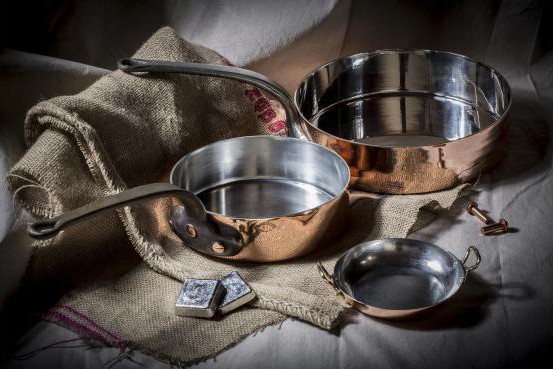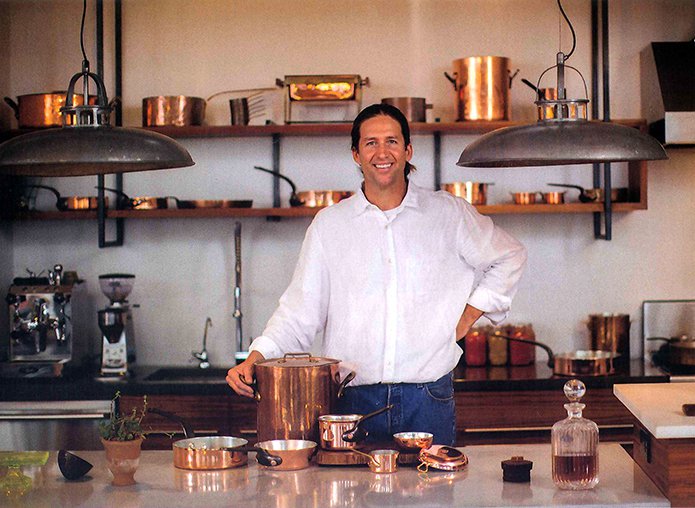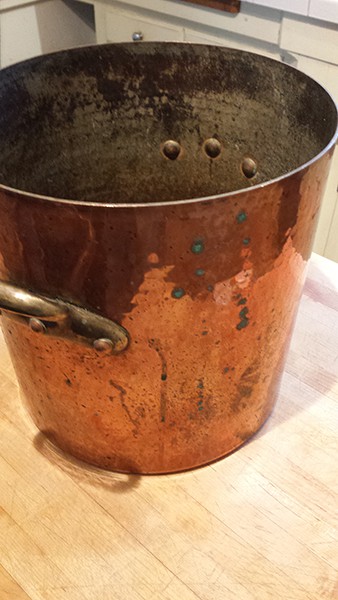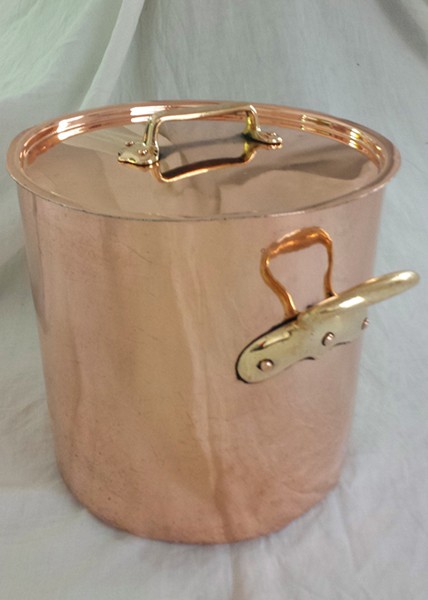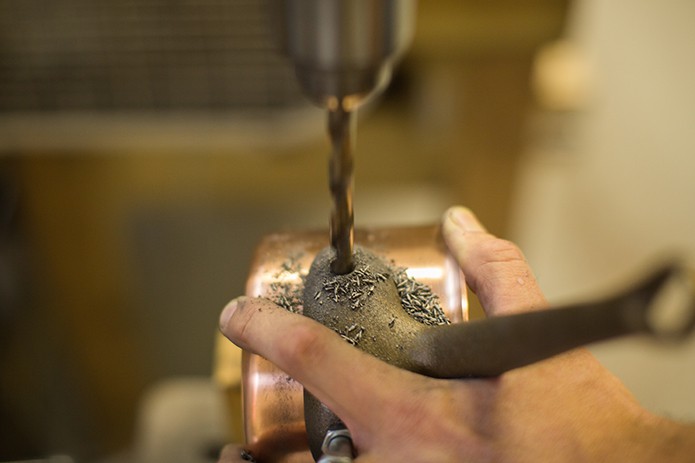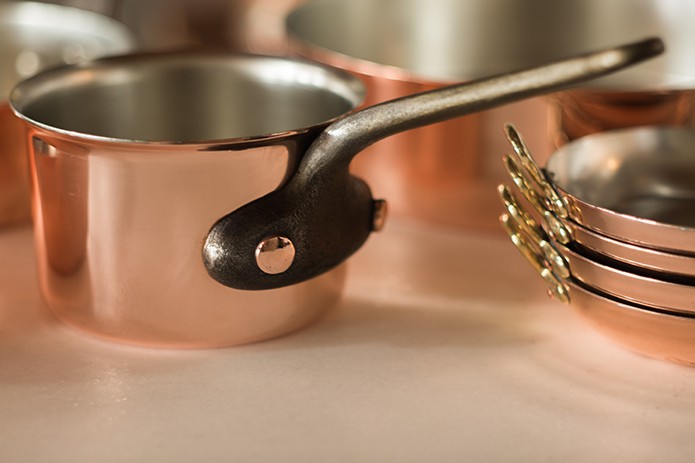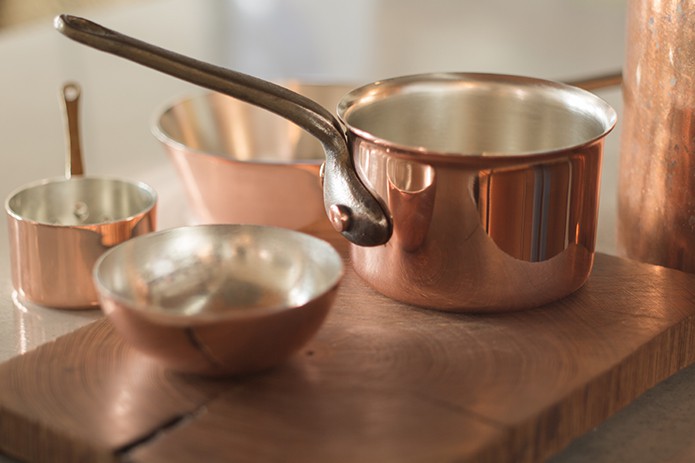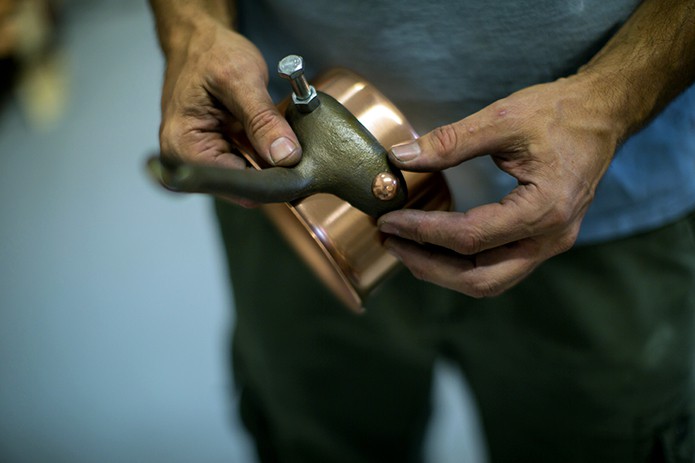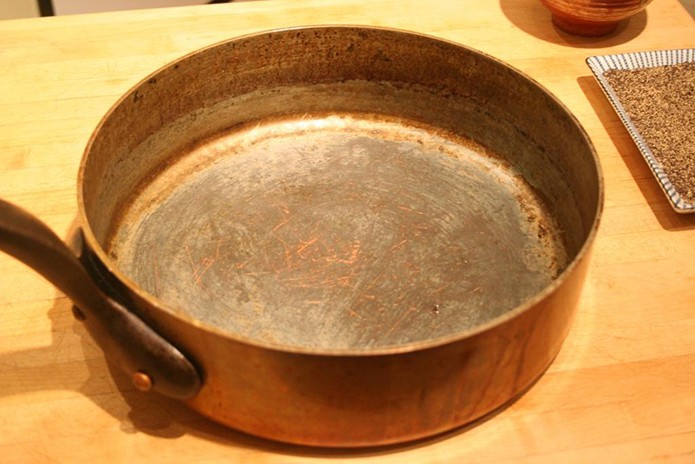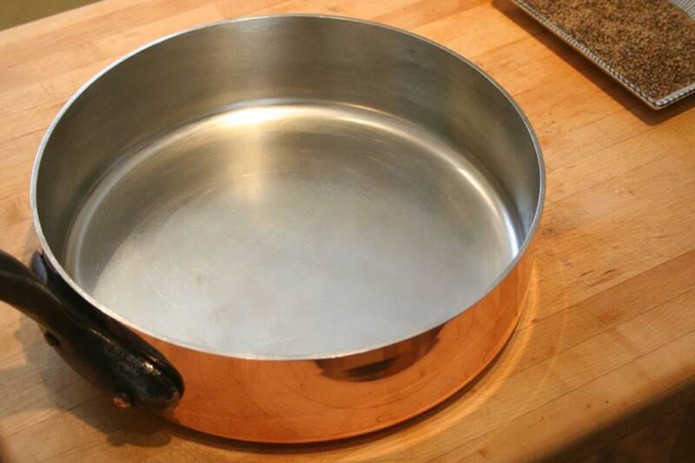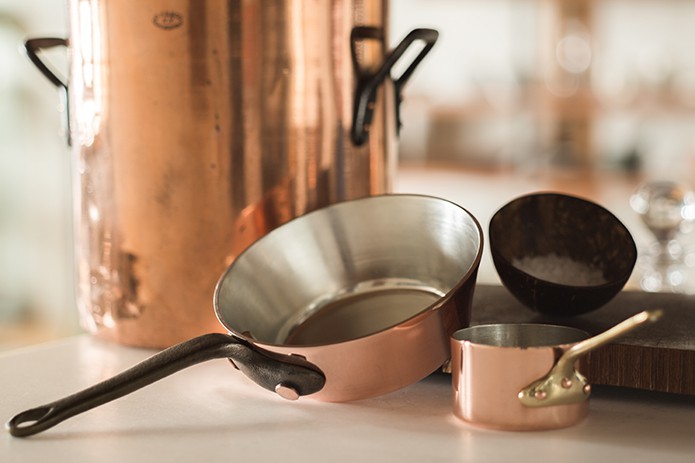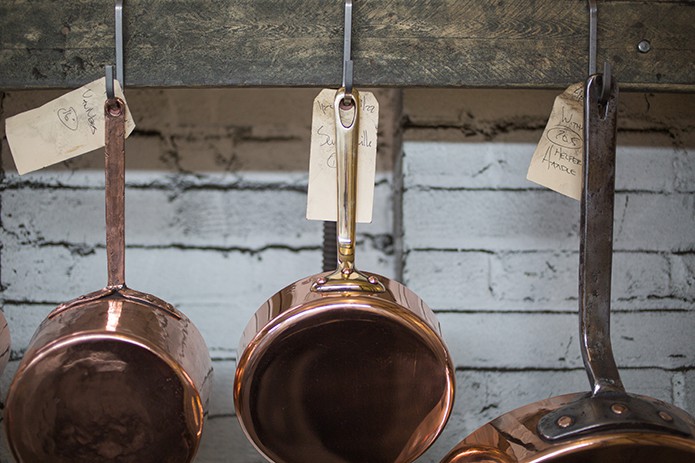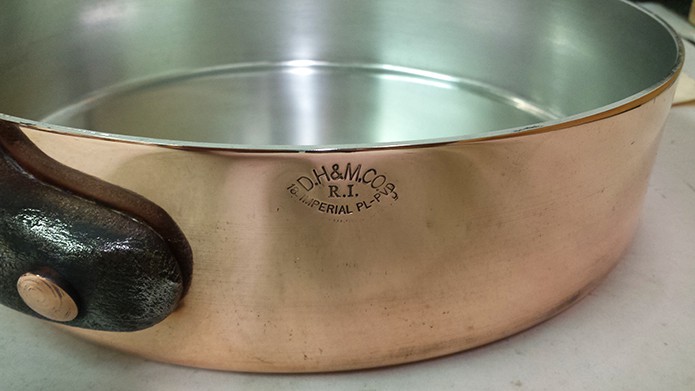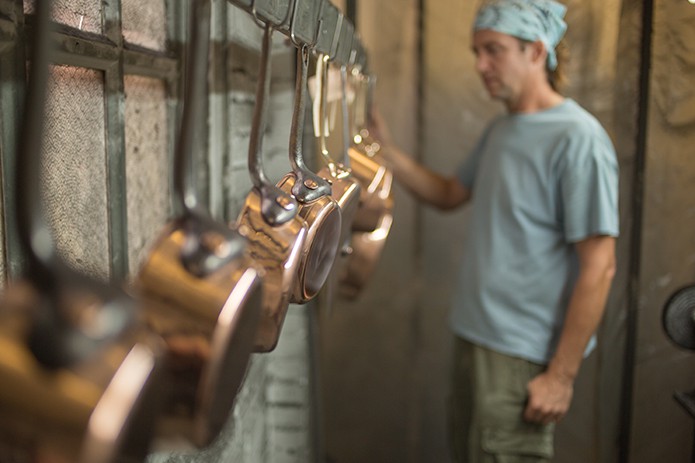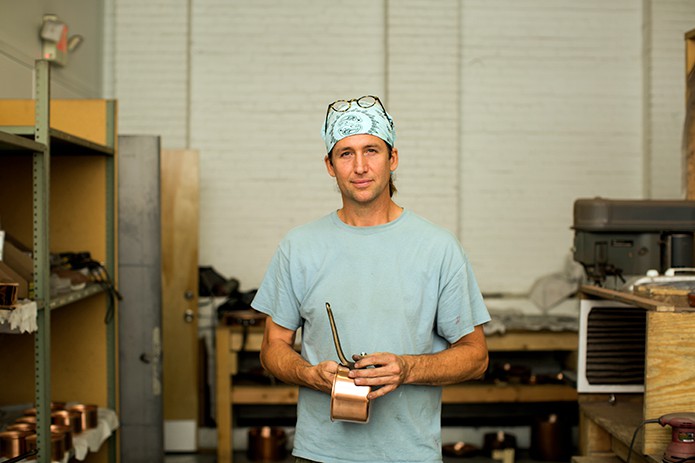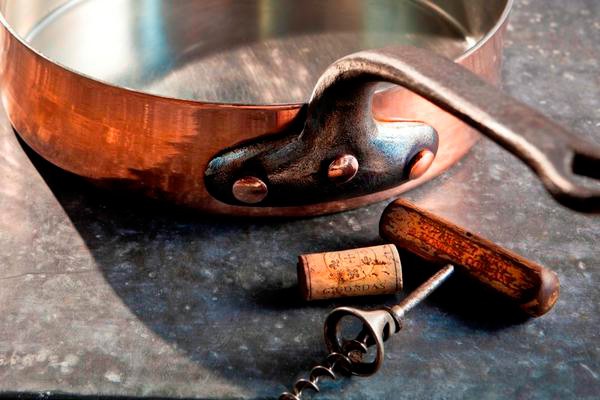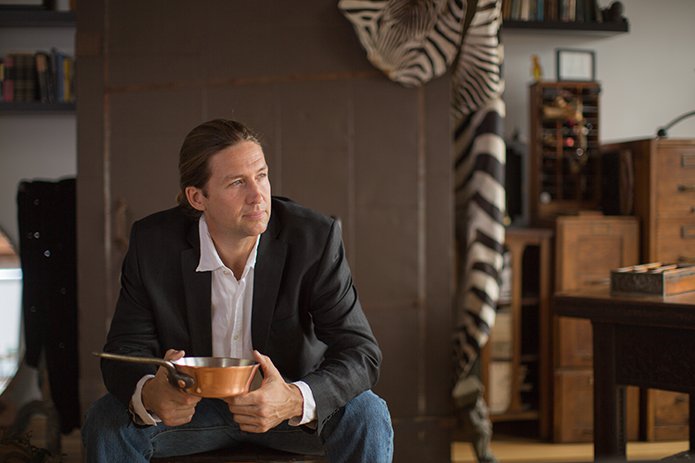
Copper cookware is prized by top chefs and serious cooks alike. Copper is a joy to cook with as well as a joy to look at. A row of copper pans gives a kitchen character and soul, whether gleaming and highly polished or gently aged to a ‘copper penny’ patina, and their presence often infers that a great culinary character is nearby; whether that is Michelin-starred chef or a revered family cook.
A love of copper pans is the inspiration behind East Coast Tinning. Jim Hamann, the founder, started up as a ‘cottage industry’ in the garage refurbishing finds in vintage stores. Since then, Jim has outgrown the garage and become a renowned name in copper craftsmanship, receiving pans from all over the world, all possessing a hidden history as either hand-me-downs, heirlooms or just lucky ‘finds’, to be revitalised by the traditional hand-wiped tinning process which lines the pan with a generous layer of tin, rendering it usable once more.
As well as refurbishing old copper pans, East Coast Tinning now expertly handcrafts reproduction copper pans, ‘Duparquet Copper’, in the style of the original classic vessels (often inspired by American & French traditions), ensuring the quality and quintessential charm of the original is carefully replicated to create a beautiful cooking vessel that is built to last.
Read on to discover how, in Jim’s own words, an East Coast Tinning copper pan, whether it is 100 years, or 100 days old, is lovingly handcrafted to look and feel wonderful whether hanging metallically majestic in a revered restaurant’s kitchen or modestly mellowed conjuring much-loved family meals in a home somewhere…
Firstly, for those readers who aren’t familiar with East Coast Tinning please can you tell us what you do?
The business of East Coast Tinning is restoring vintage copper cookware to make the pan usable again. The restorations consist of re-lining the interior cooking surface and polishing the exterior to a high shine. The cooking surfaces of vintage copper pieces are traditionally lined with tin. This tin lining slowly wears away over time with repeated cooking & washing, cooking & washing. The re-tinning of a copper piece consists of stripping out the old lining down to the copper, then ladling in molten tin to coat the interior surfaces. This process should be done as the copper begins to show thru the tin lining. A “tinning” should last 10-15 years with a frequently used pan and even longer for rarely used pieces.
Do vintage copper pots and pans merely represent nostalgia and/or a thing of beauty to hang in the kitchen, or there any actual benefits from cooking with copper?
I like to say that there are two reasons to cook in copper; the Technical – and the Aesthetic. Copper remains the ultimate technical cooking vessel. The superior heat conductivity of the metal means the cook is dealing with an evenly heated cooking surface. “Hot spots” don’t exist as the copper quickly moves the heat throughout the pan. In addition, tin-lined copper is almost inherently non-stick. We cook at lower temperatures with copper and don’t wash them hard so they build up a bit of a “seasoning” over time. So – the ultimate even heat AND a natural non-stick surface – Technically a wonderful pan…..and yes – they look great in the kitchen. Whether polished to a shine or left to a soft penny copper, the Aesthetic of the metal works in kitchens from country to contemporary.
Why is re-tinning copper cookware necessary?
Tin is an element on the periodic table like copper and iron. It is not an alloy of metals. However – unlike copper and iron, tin is a very soft metal. You can bend a bar of tin quite easily with your hands and it melts at a relatively low temperature. Tin is the metal that lines vintage copper pots and pans. The lining is necessary because copper reacts with acidic foods – like vinegars, citrus, and tomatoes. These acids will leach copper from the pan into the food. Besides tasting bad, it can turn the food green. The tin lining is a barrier that separates the food and the copper preventing this from happening.
Over time, after repeated cooking and washing, this thin tin lining eventually wears away and exposes the raw copper underneath. When this happens, a re-tinning of the cookware is necessary. With periodic retinning a copper pan can last for hundreds of years. I am frequently working on pans that are 100+ years old.
How can you determine if a piece of copperware is ready for re-tinning?
The standard rule of thumb is that when you can see a TOTAL area of copper showing thru the tin lining that is about the size of a quarter, then it is time to re-tin the piece. So – in your mind – add up all the scratches and patches of copper inside the pan. If the total is larger than a quarter dollar – about a square inch – you should have the piece retinned.
Who are your typical customers?
My typical customers are almost exclusively home cooks from the US and Canada. However, I do get an occasional order from the UK and France. The age range is broad and split quite evenly male/female. I have customers in their 70’s who learned to cook at the Cordon Bleu in Paris in the 1960’s. Then I have the 20-somethings who are into “organic” and farmer’s markets and have inherited some copper or are trying it out for the first time. No matter the customer, there are always memorable stories about where their copper pieces came from.
Can you define your Duparquet line of new copper cookware and how it compares to others out there in the market?
The Duparquet Copper line has its roots in the American and French vintage copper cookware of the early 1900’s. As I was restoring vintage copper pieces, I saw incredible, historic copper pots and pans passing thru my hands. Many of the pieces were from the early 1900’s, so about 100 years old and I was amazed at the quality and longevity of these pieces. I was seeing thick copper walls, gorgeous cast iron handles and massive copper rivets. When I compared these pans to the new copper available today, there simply was no comparison. The new copper of today had been “cost reduced” to the point that the “luxury” of the piece had been removed. The copper was thin, the rivets were skimpy and the handles were so thin they were hard to hold.
I made a decision to start making pans as they had been made – and the Duparquet line was born. The copper is 3+mm (1/8″) thick, the handles are cast iron beauties and the rivets make a statement. These pans will certainly last more than a lifetime – they will last for generations.
For someone starting out acquiring pieces for an average-sized kitchen, what are the key pieces of copper cookware you’d start with, and how would you build it from there?
I’d start with your favorite go-to shape – that piece that you are using every day. That way you’ll get the best bang for your buck. For most people I think this is a frying pan or a sauté pan with straight sides. It really depends of your cooking style and preference. My go-to pan is a 11.5″ saute pan with a lid. This shape is very versatile and the size allows me to cook for just two people – or for a party of 4-6.
Branching out from your “go-to” piece – You can start getting more specific. A splayed sauce pan (the “fait tout” or Winsor pan) is my favorite “sauce creation” pan. I can use it for making my crème anglaise or for simple, everyday sauce pan tasks.
Some people love creating stocks from chicken bones, beef bones, or lobster bodies. If this is your thing, your second pan could be a gorgeous stock pot.
The au gratin oval is also a nice versatile piece and you can go directly from the oven to the table and make a great presentation.
So, once you have your every day “batterie de cuisine” of 3-4 pieces you can start getting specific. One can get pretty crazy with copper shapes as the French seem to have designed a pan for many of their favorite dishes. There are fish poachers, braisers, the Pomme Anna potato pan, and steamers. The Italians also have a few specific shapes, so if risotto is your specialty, you can find a pan designed for risotto. In every case, these dish-specific shapes make the creation of the dish easier for you and help to concentrate flavor, create texture or drive off water as needed.
Can you talk through some of the steps you go through both re-tinning copper cookware and handcrafting a new piece from scratch?
The goal of retinning a copper pan is to provide a new cooking surface by recoating the copper with thick layer of fresh tin. The result is a surface that will provide years of safe service.
First, the old tin is removed from the interior of the pan and the raw copper is prepared to accept new tin. The surfaces are then covered with an acid flux which helps the tin adhere to the copper when heated. The outer surfaces of the pot are protected with whiting to prevent the hot tin from accidentally sticking to the outside of the pot. The pot is then heated to approximately 450 degrees Fahrenheit which is the melting point of tin. Pure molten tin is then ladled into the pot and swirled around to coat the desired surfaces. The excess tin is wiped up with a flux coated cotton cloth and the pot is allowed to cool naturally.
The traditional “hand wiped” method of retinning applies a much thicker layer of tin than “electroplating” methods. You’ll see some wipe marks in the finished product but it will last much, much longer than electroplating.
In handcrafting a copper piece from scratch, there are many ways to create a shape from a flat piece of copper. Copper is quite malleable so it can be simply hammered into shape, or pressed with hydraulics, or spun on a lathe. Liquid copper does not flow very well so copper is not usually poured into a casting.
Hand hammering is quite laborious, and hydraulic pressing is very capital intensive, so most hand-crafted pieces are formed by “spinning” on a lathe. Spinning is a versatile metalworking technique where a craftsman can make an object of nearly any circular shape by spinning a round piece of copper that is in contact with a “chuck” of a given shape. The chuck and the copper spin together as the operator works the copper disk over the chuck. Friction tools or rollers can be used to manipulate the copper. Once the copper has been formed, a handle is riveted to the pan. Finally the piece is tinned on the interior and is polished on the exterior.
How do the costs compare buying a new piece of copper cookware, or having an old piece re-tinned?
New copper cookware IS expensive! Since the 1960’s, the cost of a pound of copper has ranged from $0.50 to $1.50. However, starting in 2004, copper started a climb that took it over $4.00/lb. Compare this to stainless steel at a rough price of $0.25/lb. and you understand why copper pans can be so expensive. Copper is over 16 times more expensive than stainless steel as a raw material.
Comparing the costs of new and vintage pans – manufacturers certainly understand the cost of their raw materials and must drive prices higher as the cost of copper climbs. However, those with vintage copper pans to sell usually do not have this mindset. Many times their pricing is based on the original purchase price, which is likely well below today’s value. So it is possible to find some real deals while hunting for vintage copper cookware.
In addition, old copper pans can look pretty awful. The tarnish can be green from verdigris and the speckled grey and black of an old tin lining is off-putting to almost everyone. Therefore, for these reasons, vintage copper cookware can come to the market at VERY reasonable prices. Many times sellers do not appreciate what they have. A miserable looking copper pan can have excellent craftsmanship, tremendous character and superior quality compared to most of today’s new pans. If one can find this piece at a good price, a retinning and restoration can provide the finder with an amazing pan at a fraction of the cost of new pans.
Typically a retinning will cost about 1/3 to 1/4 of the value of the pan itself. If the pan has a desirable maker’s mark, or is exceptional quality, or has an intriguing provenance, the retinning cost may be only 1/10 the value of the pan. In addition, like silver, a restored piece of copper is almost always more valuable than an unrestored piece – with very few exceptions. As an example, I once was sent a massive turbotière that weighed ~45lbs in total. The piece was stamped with a king’s crown, the initials “L.P.”, the date of “1842” and “Le Magazin”. We had ample reason to believe this piece belonged to Louis Phillipe of France and was probably worth more as an antique (museum piece), than as a restored and functional turbotière.
Do you ever stop to think about the origin of the individual vintage pieces when handling them and the people that used them?
That is an intriguing thought, isn’t it? There are some pieces that absolutely seem to speak to you. You wonder about the hands that cooked with them, the dishes that were created in them and the people who ate from these pans.
I own two vintage DH&M sauté pans that are stamped “Waldorf Astoria” in a nice script. They were made before the 1930’s (when DH&M went bankrupt), and, at this time, the Waldorf Astoria stood on Fifth Avenue and 33rd Street. (This original Waldorf hotel was razed in 1929 to make way for the Empire State Building. The Empire State Building was completed in 1933 and the Waldorf Astoria moved to its present location on Park Avenue in 1931.) These two pans in my kitchen were probably in the hands of some mustachioed-cooks around 1910 in the basement of the hotel as they cooked for guests in the Empire Room, which was one of the best restaurants in the city at the time and rivalled Delmonico’s and Sherry’s. I imagine that they were likely French-trained and were cooking on a coal-fired Duparquet range. (There are some great pictures of these kitchens on a website for The Museum of the City of New York.) Cooking in these pans is a bit of a celebration of all those who created in these pans before me….
What should we look for when scouring markets for vintage copperware?
There are FOUR areas to consider when hunting for vintage copper. In order of importance; look for style/quality, maker’s marks, condition and price.
If you are looking to add to your own collection, you’ll take on a STYLE that you enjoy. Brass or iron handles… the older dovetailed pieces or the hammered copper look. Some collectors will like the heavy, thick 3+mm copper and others will find that this doesn’t matter to them. Firstly keep your eyes peeled for your style.
Second – are there any MAKER’S MARKS on the piece? There are telltale marks that are quite collectible and point to high quality pieces. The top French marks are Gaillard, Dehillerin, and Jacquotot. The American marks are DH&M, Duparquet, LFD&H, and Bramhall & Deane (B&D). The English have Benham & Froud whose stamp is an “orb on a staff”. Also – sometimes the hotel or restaurant will also have their own mark placed on the pan. I recently gave a pan to a chef friend in Boston. I’d found a 100 year old DH&M pan stamped “Copley Plaza” – a great piece of local history for a chef to have.
CONDITION is next. Check for any major dents, pitting, or rips in the copper. Handle rivets can be loose, but they are pretty easy to fix. Most dents can be fixed too but the pitting of the copper and any holes in the copper should be avoided.
Lastly, PRICE. I’ve found great pieces for $4, for $400, and for $1400. If it is a piece that you like, in good condition, and it fits your style. Pull the trigger if the price is something you can live with. Our ego wants to believe we got a deal, but many times the “win” is just simply finding the piece in the first place! A few times I passed on a piece because of price and I have kicked myself because I’ve never seen another like it.
You previously had a successful career in Sales & Marketing within the High-Tech sector, prior to which you gained master’s degrees in Engineering and Business from Cornell University. What prompted you to change direction completely and establish East Coast Tinning?
Well – I’m still in sales and marketing…..and still using my engineering and business degrees. I’m still trying to delight customers and grow a business with an engaged and creative team. Given my talents and interests, I have found this path is fulfilling, engaging, and exciting. The sky is the limit!
For anyone seeking to make a similar career change into a craft-based business, can you give them any advice and insights based on your own experiences?
Fall in love…
As copper is so conductive, no doubt we have to relearn what temperature to cook our food at – with that in mind are there any rules of thumb as to reducing the amount of time we need to cook for when using copper pots and pans?
The conductivity of copper is higher which means that HEAT MOVES quickly throughout the metal, but temperature is still temperature – nothing changes there. The cooking surface will be evenly heated but it will not be hotter. Your cooking times will remain the same.
What plans do you have for the future?
I am having a great time working with vintage copper and the new Duparquet copper pans. I want to keep learning and meeting creative people and pushing the agenda of copper cookware. In this crazy world that is turning ever more virtual, I feel that cooking REAL food every day in these very REAL (and sometimes historic) pans provides a sense of “knowing” that is not only important but somehow grounding as well. To me, the meal is the most important part of the day.
Thanks to Jim Hamann for taking time out of his busy schedule to answer our questions. Images courtesy of Matt Kalinowski.

